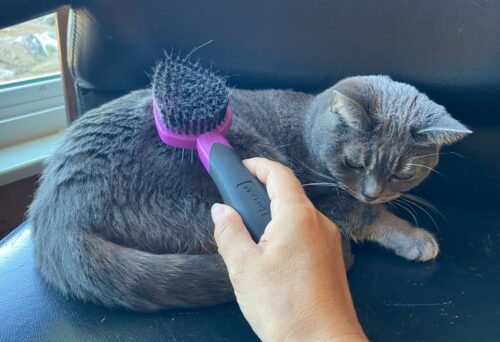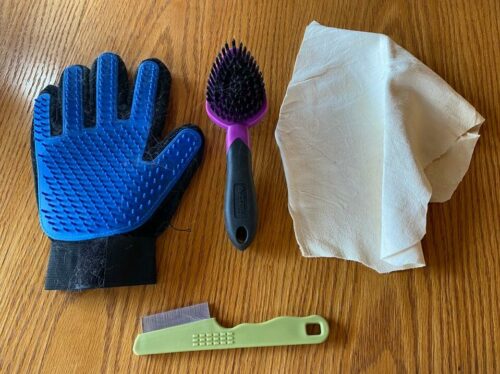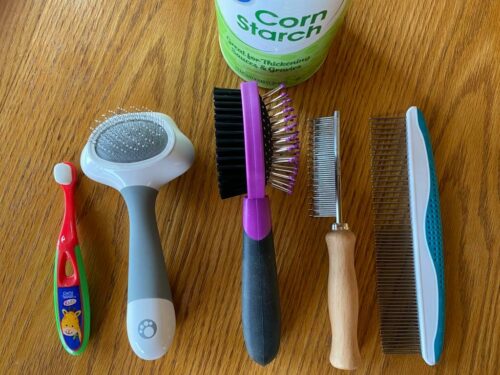
Grooming your cat at home for the first time? The key is doing it gently, with patience, so your cat enjoy it. Ideally, cat grooming sessions need to start at a young age, but don’t worry, it’s never too late to pamper your cat. Here you will learn how to groom your feline like a professional. Your results will be like the ones of the pet hair saloon, but saving your cat the stressful trip and your money.
Before Choosing Grooming tools: What to Pay Attention To
They are not all the same. When buying tools to groom your cat you need to get combs and brushes with no sharp points or teeth. According to Bailey Brush, the best combs are made of metal and need to have blunt, rounded closely-spaced teeth that will remove loose hair, effectively. The type of tools needed when grooming a cat will depend on the length of the cat’s coat.
The Basic Brush vs a Pet Grooming Kit
You can just use a simple brush to groom your cat at home. However, the point of grooming a cat is making a noticeable difference in the cat’s coat. The main goal is getting rid of tangles, death cells, and any dirt stuck in the cat’s coat. To improve your cat’s aesthetic and health you need different tools because each has a specific purpose. If you groom your cat using the wrong tool or a brush that is not suitable for your cat’s coat, it may look like everything went fine but on the end your feline friend may end up with skin irritation, skin burning or pain that will make your feline to avoid being groomed a next time.
Steps Before Grooming Your Cat at Home
1. Play with your cat for at least 20 minutes to spend his energy; your pet will stay quiet longer.
2. Test your cat’s mood by stroking him in case you don’t have time to play with your pet.
3. If your cat is nervous use a pheromone plug for 30 minutes before starting. The pheromone is the natural scent cats leave by rubbing their cheeks and other glands against objects. When the cat smells this hormone, it feels totally relaxed and safe. There are various tips to relax anxious cats you can try before the grooming session.
4. Check your cat’s claws and trim them if necessary. For a full grooming session pay attention to your cat’s ears, eyes, and teeth.
5. Check your cat’s fur and skin condition to detect fleas, ticks, or unusual lumps. Take care of this before the grooming session.
Tips During the Grooming Session
1. Start slowly in the beginning: Gently and softly stroke your cat with the brush, the first areas to brush are the head, ears, cheeks. Make sure your cat is not irritated, or extremely anxious, in that case it’s better to try again later or the next day.
2. To grooming his belly: During the grooming session test if your cat is sensitive to be touched on his belly. To test your cat, put him in a position like hugging it from behind, slightly lifting your cat’s upper body. Slowly test your cat by trying to groom the area around its belly. If your cat doesn’t let you, it’s OK. You can continue the grooming in other areas or stop the grooming if your cat doesn’t want more. If your cat feels OK, do it quickly, always comforting your cat. If your cat doesn’t let you do it for long, don’t worry, just do what you can.
After Grooming Your Cat
Every time you finish a grooming session praise and reward your kitty with its favorite treats or play its favorite game so your cat will associate the grooming with fun.
How to Groom a Short-Haired Cat at Home
Although short-haired cats don’t need to be brushed so often, it’s still a good idea to groom them regularly to get rid of debris, loose hair and improve the cat’s blood circulation. Some short-haired breeds such as Manx and British may need a deeper grooming since they have thicker coats that are more prone to mat forming.
Tools you will need: A rubber grooming pad, a fined-toothed comb aka flea comb (the flea comb is also a grooming tool), a bristle brush or baby brush and a chamois leather or a piece of silk.

Grooming a Short-Haired Cat at Home: Step by Step
- 1st Step: Begin the grooming session by loosening any dead hairs with the rubber grooming pad starting softly on the cat’s head. The rubber pad allows you to remove the excess of fur that will shed anyway plus provides a nice massage for your kitty, stimulating its circulation which improves your cat’s skin health. Make sure not to overdo this step, otherwise you can loosen too much fur on your cat. The best rubber grooming pad is the glove that allows you to groom your cat with your hand, which makes it easier and more effective.
- 2nd Step: Using the fine-toothed comb, comb your cat gently in the direction of his fur and also quickly in the opposite direction in which the hair naturally lies; this way you will deeply remove any dead fur, not only from the surface. The fine-toothed comb is the usual technique to remove any debris left on your cat’s fur. Take extra care when grooming close to sensitive areas such as ears, armpits, belly, groin and tail.
- 3rd Step: Now it’s time to use the bristle or baby brush. This allows you to remove remaining loosened debris without messing the work already done and without causing more hair to shed. Make sure to groom along the direction where the cat’s hair naturally lies.
- 4rd Step: Finally, for a super-sleek and glossy look, finish the grooming session by “polishing” your cat’s coat with a chamois leather or a piece of silk, always smoothing the fur in the direction that naturally lies. A good quality grooming is achieved when the cat looks sleek, with a glossy sheen looking coat.
Video on How To Groom A Short-Haired Cat
How to Groom Long-Haired Cats
Grooming long-haired cats is very important to keep their coat smooth, and tangle-free. When the cat’s hair gets tangled or matted it spreads rapidly along the cat’s fur with the risk of skin inflammation or even infection. If this happens grooming at home is not an option anymore and it needs to be addressed by a professional pet groomer or removed surgically. The following grooming technique is indicated for healthy coats with small mats that can detangle without the use of special tools or detangling sprays. Pay attention to the cat’s belly and legs because they usually get matted, but be gentle because cats don’t like to be touched in those areas.
Tools you will need: A wide-toothed comb or a metal comb with alternate long/short teeth, talcum powder formulated for cats or corn starch, a wire and bristle double-sided brush, a small soft toothbrush and a slicker brush for finish (optional).

Grooming a Long-Haired Cat at Home: Step by Step
- 1st Step: With a wide-toothed comb gently comb your cat from head to tail, following the natural direction of the fur. Make small sections on the coat, combing gently in the opposite direction of where the fur naturally lies. If you find small knots or tangles, sprinkle talcum powder or corn starch in the spot and rub it on the area gently, teasing the tangle apart using your fingers. This will remove excess of oil and will add bulk to the coat as well. If using a metal comb with alternate long/short teeth it’ll be easier to work on the cat’s ruff, forelegs and pants (the fur of a cat’s hind legs).
- 2nd Step: Use the wire side of the double-sided brush to remove excess of hair and talcum, grooming gently to avoid hair to break off or skin irritation if used too firmly.
- 3rd Step: Now use the bristle side of the brush, working along the lie of the fur to remove small particles and fur what the wire side of the brush didn’t. Brush the topcoat and undercoat (in case your cat has double coat). The soft brushing will make the coat look full and shiny.
- 4rd Step: Use an ordinary toothbrush (not too wide) to groom the facial area of your cat. Do it very carefully and gently.
- 5th Step: Finally, use the slicker brush, for finishing. The slicker brush allows the coat to fluff up the tail, the back and neck if you have a Persian. This step is optional. The result is a smooth, shiny, fluffy and tangle-free coat. A well done grooming session should last about 15 to 30 minutes.
Importance of Grooming Your Cat
Grooming is a very important aspect in the cat’s life, actually is a sort of social bond between cats. Cats groom each other helping in the areas that cats can’t reach, such as behind the ears and the back of the neck. If you have a single cat, it will certainly appreciate your extra help.
Benefits of Grooming Your Cat
- By grooming your cat you remove loose hair, dead skin cells, dirt, and oil. Brushing a cat properly improves the cat’s blood circulation, stimulating a healthy skin.
- A good grooming session provides your cat a good massage, helping the cat’s joints through improving blood circulation, it relaxes its muscles and nerves, relaxing your cat totally and reducing anxiety.
- Grooming sessions help you to develop a close bond with your kitty.
- You have the opportunity to check on your cat’s body to make sure it doesn’t have any issues, such as ticks or fleas, lumps or bumps, hidden injures, or if your cat has lost or gained weight.
- It helps to remove excess of fur that otherwise, will be swallowed by your cat when grooming himself. Cats usually throw up or pass hairballs, but sometimes this could become a serious problem if the fur ball gets stuck in the cat’s intestine. By removing the excess of fur you reduce the formation of hairball in your cat.
- It keeps your cat’s coat from forming tangles and mats. This is extremely important for cats with very thick coats, such as Persian or Maine Coon.
- A helping hand for elderly cats. When cats get older they don’t groom themselves as good as when they are young.
Frequency to Groom Your Cat At Home
The frequency of grooming your cat will depend on your cat’s hair length. Can you brush your cat too much? Yes you can, especially if using tools like the rubber glove that removes a fair amount of hair. When brushing your cat you only want to remove the loosing hair but not the healthy coat that protects your cat from the temperature, plus excessive brushing leads to skin irritation in your cat. The ideal frequency of grooming (brushing) your cat is the following:
- Short-haired cats: Once a week
- Long-haired cats: Every other day
- Long-haired cats with double coat: Every day. These cats need regular grooming to avoid their fur from getting tangled or matted.
That’s all you need to know to groom your feline friend the right way. It may take several tries before your cat allows you to groom him in a full session. But it’s worth it. Your kitty certainly will appreciate it.
Sources:
- The Complete Cat Book, by Paddy Cutts
- Baileybrush.com
- Petvetcarecenters.com
Leave a Reply